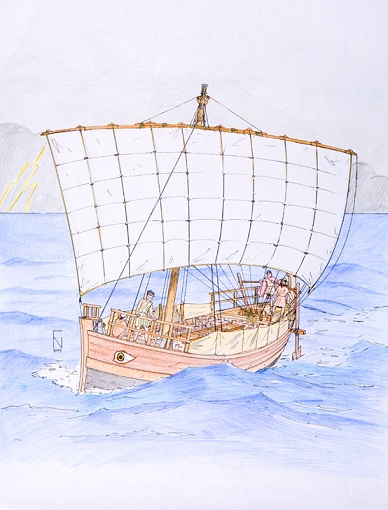The Giants of the seas of the Hellenistic Time
The Hellenistic Age spreads from the death of Alexander the Great in 323 B.C. to 30 B.C. the year of the death of the last of the Ptolemies, Cleopatra VII, (some historians however consider that the Hellenistic World in the East continues up to the third, even the fourth century A.D. until to the end of paganism) was the age of the gigantism in the merchant vessels and the military fleets. The multiremes developed and increased in size and in number of banks of oarsmen. We are familiar with the biremes and the triremes – iconographical documents and texts help, as well from the recent attempt in experimental archeology carried out with the 37-meter long trireme “Olympias” — however when it comes to larger ships, with more ranks of oars we fail to understand the intricate structure.
Notwithstanding the unsolved queries for most of the polyremes, it is a fact that during the Hellenistic times we have a large number of representations of ships, including numerous graffiti, which have greatly helped scholars in the field to understand the intricate method of ship construction. Some of these ships were enormous and could probably be harbored only in very large ports as Alexandria and Syracuse.
The graffiti of Delos, a priceless discovery of incised representations of ships on the stucco of walls of ancient houses, were made in the 1st century A.D. probably by sailors, who not only could draw well but could also render in every detail the ship they understood and loved: their own ship.
When in the early 1980’s the Kyrenia II project started — this unique attempt to build a merchant ship of the Classical Greek times – scholars based the reconstruction of the lost parts of the ship and the missing equipment and fittings by attentively studying the “ships of Delos”. These graffiti were of great help for making the mast, the sail, the rigging and steering mechanism.
The researchers in nautical archeology are much indebted to the Delos graffiti and to the French Commander Carlini, Naval Attaché at the French Embassy in Athens, who in 1933 made the first sketches of these ships. Later in the 1970’s Lucien Basch, a Belgian scholar specializing in the ship iconography, revisited what could still be seen of the ships depicted by Carlini half four decades earlier and continued discovering a multitude of other graffiti of ships on the sacred island of Apollo.
Giant merchant vessels and warships of the Hellenistic times have not survived or let’s better say have not been discovered yet. But there is certainly a hope that with the new technology — that allows research in very deep waters (surveys at depth of 1,500 to 2,000 meters are possible by”ROV” Remotely Operated Vehicles) – such ship wreck may come to light. According to ancient sources we cannot exclude that their length reached or even surpassed the 80 meters. Some enormous lead stocks and assembly-collars of composite anchors which were found in the Mediterranean Sea must have pertained to these giants vessels. We know that such enormous cargos were used for the transportation of grains.
It was usual for the trade vessels of the Greco-Roman times to be as long as 50 and 60 meters. During the years that followed the Roman conquest of Greece the waters of the Mediterranean witnessed the continuation of the gigantism of the Hellenistic years and super-cargos that had made their first appearance one or two centuries earlier kept being built for the necessities of the Roam expansion.
The two ships of Lake Nemi, although used solely for ceremonials not trade, measured circa 70m in length and as they had been raised and restored in the between the two Word Wars period, their presence in Nemi, near Rome, witness to the presence of those colossal floating structures.
But there are also great works in sculpture that testify to the presence of these large achievements in naval architecture. To mention only two among the most famous: The masterpiece of Greek statuary that is known as the Nike of Samothrace, now kept in the Louvre, depicts the Victory standing on the prow of a large warship, this was a dedication of the Rhodians to the shrine of Samothrace. But a Rhodian sculptor, Pythocritos, carved on the rock of Akropolis of Lindos an enormous trireme, that has been preserved and is rich in structural details.
It is however on the Hellenistic coins that we found precious miniatures of a variety of ships or of parts of ships. The warship in particular was then a preferred subject for such artifacts.
During all the Roman period, ships kept been built on the Greek mainland and the islands, as well as on the shores of Ionia and other Greek coastal centers of Asia Minor, although the large shipbuilding centers moved westwards on the Italian peninsula. At the end of the 1st century A.D. Mediterranean becomes a Roman Sea, a Mare Nostrum.
Roman strict customs did not allow its citizens to become merchants or shipowners. However, Rome did need the services of a merchant marine, and although later on in their history they relaxed their rules out of necessity and greed, they did have to rely on the traditional maritime people, the Greeks, to carry out the sea trade. Thus, the maritime policy of Rome was to ensure for these traditional maritime people and their ships, freedom of the seas and freedom of their maritime trade. This they did through a number of measures such as building new ports, upgrading existing ones, opening canals, installing lighthouses, and above all, protecting the merchant ships, especially from pirates.
It is interesting to note at this point that during Roman times, we see the beginning of the passenger and tourist trade who traveled on board merchant ships.

